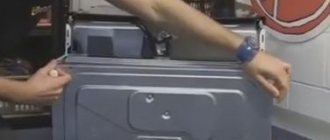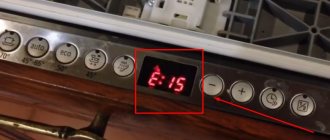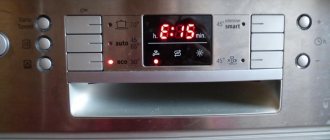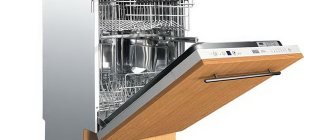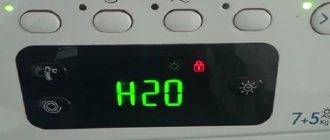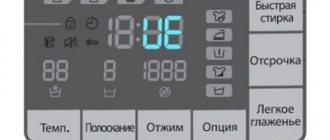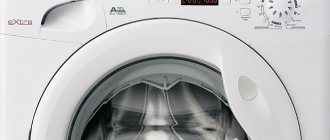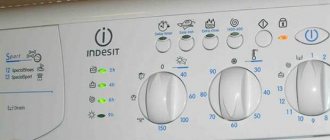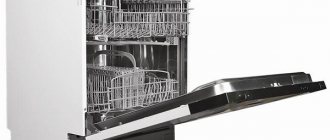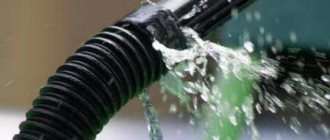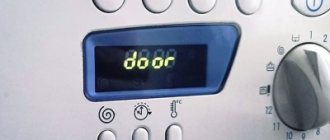Due to the growing demand for dishwashers in Russia and the CIS countries, an increasing number of users are wondering what to do in case of problems, such as water leakage or, conversely, the dishwasher does not fill with water. Modern devices are equipped with a warning system, and in the event of a certain type of malfunction, a digital code will be displayed on the display. Each model has its own system.
This code is typical primarily for Hansa brand dishwashers
Error e4 is one of the most common malfunctions that periodically occur in dishwashers. To eliminate it, you will first need to find out the reason for its appearance, which will be discussed in this material.
How to drain water from a dishwasher for the winter?
Lower the entire length of the drain hose to the floor, removing any remaining water from the drain hose and chamber. Open the filter located at the bottom of the washing chamber. Make sure there is no water in the filter bowl. If there is water, put a rag down, let the water soak in, then remove the rag.
Interesting materials:
How to store cauliflower at home? How to store things in a closet on shelves? How to store a knitted mink hat? How to store winter varieties of apples? How to boil a kettle with lemon? How to boil an electric kettle with soda? How to boil kitchen towels with vegetable oil? How to boil kitchen towels? How to boil towels? How to boil dishes with office glue?
Decoding the code
Error code e4 in a dishwasher means “too much water.” This may mean that one of the pipes is leaking, or the plug on the inlet hose has become unusable, which is why liquid has accumulated in the tank with a volume exceeding the permissible norm. You can repair this fault with the help of a specialist or with your own hands. However, the services of a specialist are expensive - about 8 thousand rubles, so it will be easier to do the repairs yourself.
When error e4 occurs, the aquastop emergency system is activated. This means that the pan is full, and now it’s impossible to do without at least the initial draining of all the stagnant and non-flowing water. This is an initial measure and in order to understand how to fix error e4 in a dishwasher, you will first need to disassemble it and repair the broken parts. Next, we will look at the possible causes of leaks inside the machine and ways to eliminate them.
Possible causes of leaks inside the dishwasher
It is difficult to understand the reasons for the error without opening the housing and checking the sockets, pump and other elements of the drainage system. However, here it is necessary to mention the most common of them:
- Hose coming off the pump
- Leaking drainage system pipes
- Pump malfunctions
A slipped pipe as a possible cause of dishwasher flooding
How to disassemble a dishwashing machine
Remember that there are two ways to troubleshoot a dishwasher - repair the faulty element or replace it with a new analogue.
In any case, the algorithm for disassembling a Hansa dishwasher is as follows:
- the unit is de-energized from the electrical network;
- the water supply is shut off, then the fastening clamps on the water intake hose are loosened;
- in case there is liquid left in the dishwasher, you should prepare a bucket and plenty of floor rags;
- All containers intended for loading dirty dishes are removed from the washing hopper;
- The dishwasher is neatly laid on its side;
- The screws holding the back panel and tray are unscrewed. By the way, the top cover should also be freed from its fastenings. Such measures make it possible to inspect not only the pump, but also the remaining internal elements of the dishwasher;
- All that remains is to remove Aqua-Stop from the dishwasher, which in most cases reliably protects against the occurrence of error E4.
We hasten to warn you that the protective system in older models quite often does not pay attention to small leaks. In such situations, the leak problem is identified in the old way - by visually searching for traces on the floor.
Meanings of error codes and recommendations for troubleshooting Gorenje breakdowns
Below we list the designations of fault codes that the user may encounter when operating the Gorenye dishwasher. In the tables below, the causes are presented in rating form, starting from the problem with the greatest probability and ending with the least.
E1 – activation of the leakage sensor and detection of water in the tray
Appears if the float sensor of the “Leakage Protection” system is closed for more than 3 minutes, if water leaks into the pan. In this case, the pump will operate until the element contact opens.
| Cause | How to fix |
| Water entered the pan due to a leak in the tank from the Aquastop system hose. Internal components of the housing may also leak - pump, recirculation pump, etc.; connecting pipes. | Drain the tray so that the contact of the tank full sensor opens. This is followed by restarting the dishwasher to check and find the location of the leak. The leakage is eliminated and the machine can be used. |
| The fill sensor is stuck. | You need to open the sensor, returning it to its working position. |
| The overflow sensor is broken. | The sensor needs to be replaced and the dishwasher needs to be restarted. |
| Breaks in the wiring. | You need to check the wiring, connectors and contacts of the leakage sensor and system board. Damaged sections of wiring require maintenance. |
| Damage to the control unit. | A malfunction of the electronic board is obvious if none of the four failures listed above are confirmed. How to reboot the machine to determine the module failure: · run the dishwasher; · select the washing mode; · close the loading hatch; · if after 3 minutes or less the PMM displays error code E1, it means that the problem is still in the unit and it needs to be replaced. |
E2 - the level sensor of the Gorenye dishwasher has tripped
The system signals error E2 if the water level has crossed a certain mark and an overflow is detected. The Gorenye dishwasher stops the user-specified program, starts the pump to drain the water, and displays an error on the display (or the indicators flash).
Important! To immediately rule out a failure of the control board, you need to carry out the following check:
- Remove the side wall and check that the pan is not full (the float may have tripped).
- Drain the dishwasher by emptying the tank.
- Disconnect the PMM, disconnect the blue wire from the pressure switch connector.
- Turn on the machine.
- Enable program No. 1.
- After starting the program, the following situations may occur: 1. Draining will start. This will mean that the electronics correctly detected the signal and worked, which means the control unit is working. 6.2. The PMM will begin to pour water into the system. This means that the electronic system misinterpreted the signal, the control unit has failed and needs to be replaced.
| Reasons for the error | How to fix the problem |
| Incorrect installation of the pressure hose to the level switch. | The rubber hose needs to be checked: there may be ruptures or breaks in it. If there are breaks in the hose, there will be a loss of pressure, which means the element will not be able to perform its functions. |
| Water has entered the pressure supply hose to the level switch. | In this case, you need to disconnect the hose from the sensor and inspect whether there is water in it. If there is, the part needs to be replaced with a new one. |
| The level relay has failed. | After emptying the dishwasher tank, check the operation of the pressure switch using an ohmmeter. If the relay needs to be replaced, install a new part. |
| Broken or clogged wash pump. | Select a mode and turn it on. Make sure the pump delivers water evenly without creating bubbles. If the water supply is intermittent, you need to inspect the pump hose that passes through the pan - it may be clogged. If the problem is not solved, the part needs to be replaced. |
| The water intake rate at the inlet valve has been exceeded - the rarest cause of this error. | The repair involves closing the water valve to regulate the pressure of the water flow. After this, reboot the device several times to make sure the problem is resolved. If the E2 code comes back on, the intake valve will need to be replaced. |
E3 – no heating
Warning lights or an error code appear on the user panel when the water heats up too slowly - less than one and a half degrees in 20 minutes.
| Causes | How to fix |
| Triggering of the heater thermal fuse (if one is provided in the design). | Using a tester, measure the resistance of the fuse. If “0” lights up on the device screen, it means “closed”, there is no operation. If the measurements report: “open,” then the fuse has tripped to protect the heating element from overheating and burnout. In the latter case, the thermal fuse trips due to one of two possible reasons: 1. The thermistor position is broken. 2. The washing pump is deformed. |
| The heating element is broken. | The heater should be checked using an ohmmeter. Measure the resistance by applying the probes of the device to the contacts. Normal values are within 25 Ohms (at room temperature 20 degrees). If the measuring device shows a “break”, then the heating element is faulty and needs to be replaced. |
| Incorrect thermostat setting. | Check that the thermistor is installed correctly by adjusting it in the socket. Replace if necessary. |
| The integrity of the wiring is broken. | Perform wiring maintenance by checking the integrity of the connections on the dishwasher parts and its control module. Use a tester: measure the resistance by applying probes to the board connectors. Once you find damaged areas, repair them. |
| The impeller (sprinkler) has stopped rotating. | Check whether the element rotates freely. If something interferes with it, the heat is distributed incorrectly. |
| The washing pump is broken. | If the washer pump stops working, water stops circulating in the system and therefore does not heat up (at this moment the heater thermal fuse could have tripped). The pump and fuse need to be replaced. |
| Control unit failure. | If the above breakdowns are not confirmed, this may mean that the relay that controls the operation of the heating element was broken. Using an ohmmeter, measure the voltage at the heater connector as it heats up. At this moment, the terminals should produce 220 Volts. Voltage control needs to be carried out for a couple of minutes, because the heating element does not start immediately after switching on; It takes time to diagnose a breakdown. If the failure is confirmed, the module needs to be replaced. |
E40 – the temperature sensor circuit is broken
You will see this code when the PMM is turned on and the sensor is not working. Malfunction is rare if the dishwasher is used correctly. A failure often occurs as a consequence of previous repair work - wiring maintenance or replacement of a module or detergent dispenser.
To solve the problem yourself, try using our recommendations.
| Cause of malfunction | How to fix |
| The integrity of the wires is broken. | Check how reliable the element's wiring and its connection to the electronic board are. If you find defective areas, carry out maintenance. |
| The thermistor is broken. | Armed with a multimeter, measure the resistance of the thermostat - it should be at the level of 12 kOhm at a room temperature of 20 degrees. If an open circuit is detected, this indicates a breakdown and requires replacement. |
| The control unit does not receive signals from the thermistor. | If the previous reasons are not confirmed, and the sensor readings do not reach the control unit, most likely the problem is in the electronic board itself. It needs to be changed. |
E5 – the dishwasher does not fill with water
This code usually lights up when water is filled into the dishwasher if the required level is not reached within a 7-minute period.
| Possible problems | How to fix |
| The valve on the water supply pipe is closed. | Try opening the tap. |
| The inlet hose is pinched or twisted. | Check whether the fill hose in the PMM is not pinched. Also inspect the filter mesh on the machine body, at the hose inlet. Straighten or install the hose correctly. At the same time, wash the filter mesh. |
| The contacts in the intake valve circuit are broken. | Check the integrity of the connections between the intake valve and the electronic board. Run the tester in ohmmeter mode to measure the resistance and check if the connections are OK. Once you find damaged areas, get them repaired. |
| The water intake valve coil has broken. | It is necessary to check the coil with a tester. If a break is detected, the valve is broken and requires replacement with a similar one. |
| Block failure. | If the wiring is fine, take a tester to check the voltage at the solenoid valve. When filling, the power supply to the part should be at 220V. If there are no indicators, then the module needs to be changed. |
E6 – no draining
Alarm code “E6” lights up when draining if the tank is not emptied within three minutes.
| Crash | Troubleshooting |
| The drain hose is out of position. | Check that the hose is installed correctly - it may be pinched or kinked. Install the hose so that it is positioned freely. |
| The pressure switch is broken. | After draining the water from the PMM, use a tester to measure how the level sensor switches. If a problem is detected, change the pressure switch. |
| The drain pump is broken. | Check the operation of the drain pump. You will need a tester to check the resistance at the connector where there should be no breaks. If the pump winding is broken, the pump is broken and needs to be urgently reinstalled. Sometimes the pump stops draining when the ohmmeter readings are normal. Replace the pump if you cannot find the cause of the failure. |
| Violation of the integrity of the wiring going to the pump. | Make sure the connections (wires) of the part are in order. Check with a tester and repair the damaged areas. |
| The control unit has failed, stopping the pump from starting or receiving signals from it. | Check with a tester whether the pump receives voltage from the block when draining - it should be 200V. If the operation of the part is not impaired, but its signals that the tank is already empty do not reach the module, the electronic board may fail. Both cases require block replacement. |
Errors H1, H2, HE, HE1, HE2, HC, HC1, HC2, E5, E6 Samsung washing machine
What's happened
The washing machine display showed an error message H1, H2, HE, HE1, HE2,
In models without a display, the indicators of all washing modes + the bottom and second temperature indicator from above light up
or indicators of all washing modes + two central temperature indicators.
Do not confuse with the 2H, 3H or 4H indication - this is the time until the end of the wash.
When the error appears
The error appears if you select a washing temperature of 40°C or higher. If you select a lower temperature, the error will not appear.
Why did the error appear?
There are several reasons:
What to do in case of breakdowns?
If an error code appears on the display, then first of all you need to rule out a system failure. Unplug the plug and restart after 10-15 minutes. If the code is not shown, you can continue working. If it lights up again, refer to the table in the operating instructions, or save this page.
Error E1
Indicates that the waiting time for the cooking chamber to fill with water has expired. There is no water in the system.
There can be quite a few reasons:
For further actions, it is advisable to invite a specialist.
Error E2
Water does not drain into the sewer.
It is better to delegate further actions to a specialist:
Error E4
Overflow. Water has accumulated in the pan and the float sensor has tripped. The Aquastop protection is faulty.
How to fix problems
Having finished disassembling the Hansa dishwasher, you need to carefully wipe up the remaining puddles on the floor and begin inspection. If the hose leading from the pipe to the pump is torn off, it is necessary to loosen the clamps securing it, remove the hose and inspect it inside and out. It happens that the hose breaks from its normal place due to the excess pressure created.
The reason for this could be severe blockage inside the hose or at the place where it connects to one of the pipes. The role of blockage can be played by scale, remaining mineral salt, and other chemical elements that form sediment in the dishwasher. After some time, the salt particles harden, forming a strong barrier and threatening the entire drainage system with breakdowns.
Another common problem with error E4 is a leak in the drainage system. Water can seep in at joints or through damaged areas of the hull. The first option can be eliminated simply - tighten the clamps, change the gaskets made of rubber material. In the event of a leak through the housing, you will have to look for the failed element and replace it with a new spare part. Temporary measures are not used here - the situation can worsen at any moment, and error E4 will result in a significant breakdown.
What to do in case of breakdowns?
If an error code appears on the display, then first of all you need to rule out a system failure. Unplug the plug and restart after 10-15 minutes. If the code is not shown, you can continue working. If it lights up again, refer to the table in the operating instructions, or save this page.
Error E1
Indicates that the waiting time for the cooking chamber to fill with water has expired. There is no water in the system.
There can be quite a few reasons:
For further actions, it is advisable to invite a specialist.
Error E2
Water does not drain into the sewer.
It is better to delegate further actions to a specialist:
Error E4
Overflow. Water has accumulated in the pan and the float sensor has tripped. The Aquastop protection is faulty.
Error E8
Flow sensor is broken.
Fault marking meaning
It would seem that everything was done correctly: all the necessary ingredients were added (from salt and rinse aid to the appropriate detergent). The device will turn on and water will flow through its hoses. However, literally five minutes later a message appears about error code E1.
To get started, you can refer to the instructions. The transcript provides data on long-term activation or closure of the valve. The latter means that no water is supplied. This can happen for the following reasons:
- low water pressure at the inlet from the water supply system;
- it is necessary to check the sensors;
- If the above points are denied, the malfunction may be due to a broken electrical circuit inside the device.
